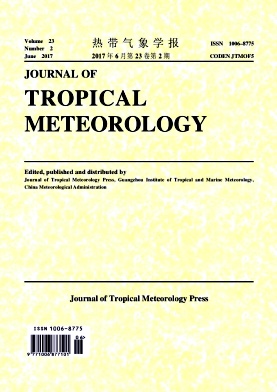THE CONTRASTS BETWEEN STRONG AND WEAK MJO ACTIVITY OVER THE EQUATORIAL WESTERN PACIFIC IN WINTER
doi: 10.16555/j.1006-8775.2017.02.002
- Rev Recd Date: 2017-03-24
Abstract: This paper investigates the contrasts between strong and weak Madden-Julian Oscillation (MJO) activity over the equatorial western Pacific during winter using the NCEP reanalysis data. It is shown that the MJO over the equatorial western Pacific in winter shows significant interannual and interdecadal variabilities. During the winters with strong MJO activity, an anomalous cyclonic circulation lies east of the Philippines, strong anomalous easterlies control the equatorial eastern Pacific, and anomalous westerlies extend from the Indian Ocean to the western Pacific in the lower troposphere, which strengthens the convergence and convection over the equatorial western Pacific. The moisture convergence in the lower troposphere is also enhanced over the western Pacific, which is favorable to the activity of MJO. Eastward propagation is a significant feature of the MJO, though there is some westward propagation. The space-time spectral power and center period of the MJO are higher during strong MJO activity winters. The anomalous activity of MJO is closely related to the sea surface temperature (SST) and East Asian winter monsoon (EAWM). During strong MJO activity winters, there are positive/negative anomalies at high/low latitudes in both sea level pressure and 500 hPa geopotential height, and the temperature is lower over the central part of the Chinese mainland, which indicates a strong EAWM. China experiences more rainfall between the Yellow and Yangtze Rivers, but less rainfall south of the Yangtze River. The SSTA is negative near the Taiwan Island due to the impact of strong EAWM and shows a La Niña pattern anomaly over the eastern Pacific. During the weak MJO activity winters, the situation is reversed.
| Citation: | CHEN Xiong, LI Chong-yin, TAN Yan-ke, et al. THE CONTRASTS BETWEEN STRONG AND WEAK MJO ACTIVITY OVER THE EQUATORIAL WESTERN PACIFIC IN WINTER [J]. Journal of Tropical Meteorology, 2017, 23(2): 133-145, https://doi.org/10.16555/j.1006-8775.2017.02.002 |

















 粤公网安备 4401069904700002号
粤公网安备 4401069904700002号
 DownLoad:
DownLoad: